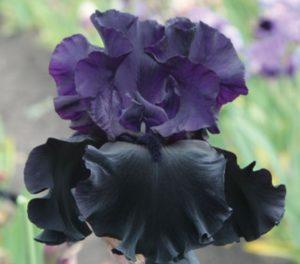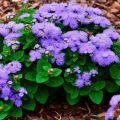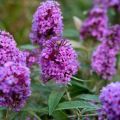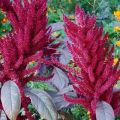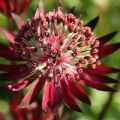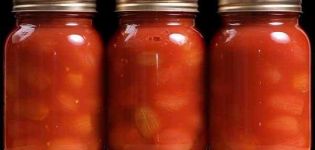Description of the best varieties of cosme, planting and care in the open field
In summer cottages, you can often find tall purple daisies. But not everyone knows the name of this flower. The plant is called - kosmeya. Planting and caring for cosmea outdoors is pretty simple. You don't have to put in a lot of effort to grow a flower of this variety.
Content
- 1 Description
- 2 Features:
- 3 Types and varieties
- 3.1 Double feathery
- 3.2 Dazzler
- 3.3 Purity
- 3.4 Undersized
- 3.5 Sulfur yellow
- 3.6 Bilbo
- 3.7 Crest Lemon
- 3.8 Diablo
- 3.9 Blood red
- 3.10 Brightness
- 3.11 Antiquity
- 3.12 Double click rose bon-bon
- 3.13 Terry
- 3.14 Golden Valley
- 3.15 Polydor fox
- 3.16 Red Pyle
- 3.17 Burgundy button
- 3.18 Chocolate
- 3.19 Dwarf
- 3.20 Sensation
- 3.21 Sonata
- 3.22 Seashell
- 3.23 Pikoti
- 4 Features of growing from seeds
- 5 Care
- 6 Diseases and pests
- 7 Collection and storage of seeds
- 8 Wintering
- 9 Use in landscape design
- 10 Reviews
Description
Kosmeya is perennial and annual. The plant belongs to the Astrov family. The birthplace of culture is Spain. The flower grows beautifully in Russian latitudes, even in the northern regions. The culture grows well in arid regions on sandy soil. In nature, there are about 25 varieties, but in Russia two types are most common - sulfur-yellow and double-pinned cosmeya.
Depending on the variety, the inflorescences are either regular or terry. The shade of the petals is also different. From white to deep burgundy. Kosmeya is tall and short.
Features:
The height of the bushes can vary from 60 cm to 1.5 m. The inflorescence is very similar in appearance to chamomile. Most varieties are characterized by the usual type of inflorescence. But relatively recently, breeders managed to bring out terry kosmeya.
Types and varieties
There are a large number of varieties of cosme, which differ from each other in a number of characteristics.
Double feathery
The most widespread variety of cosmea in Russia is double-pinned. These are annual hybrids with large inflorescences, they can reach up to 10 cm in diameter.
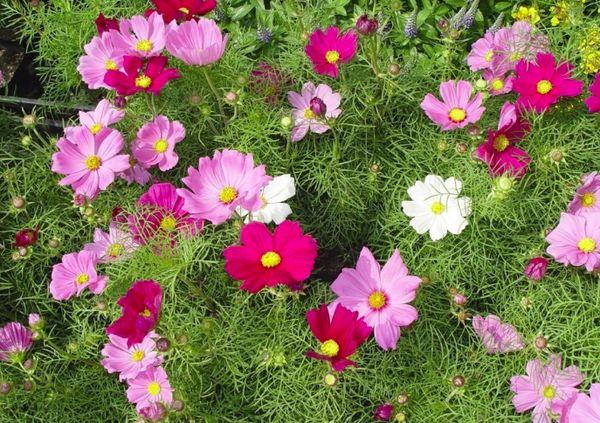
Dazzler
Inflorescences of a bright red hue, which gradually acquire a crimson color.
Purity
Purity's stems are thin and flexible, the shade of the petals is snow-white.
Undersized
The height of the bushes is not more than 65 cm. Inflorescences are of various shades. Most often there are pink inflorescences with a red border in the center of the flower.
Sulfur yellow
This variety was brought from the southern regions of Mexico. It prefers to grow in areas with hot summers. It grows poorly with prolonged rains and constant cold snaps.
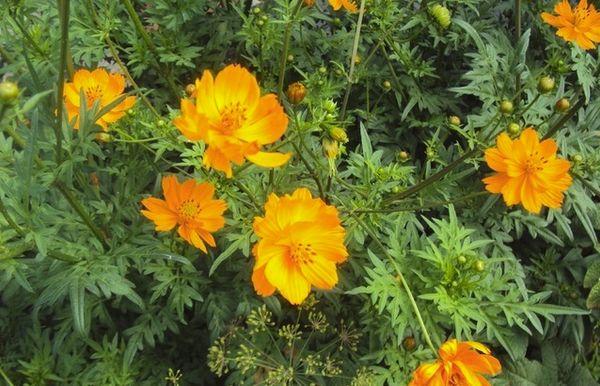
Bilbo
Low-growing variety, the height of the stems grows up to 50 cm. The inflorescences are rich yellow-orange.
Crest Lemon
The height of adult bushes is 50 cm.The petals are yellow.
Diablo
The height of the bushes is from 60 to 85 cm. The petals are red with a yellow border in the center.
Blood red
It grows only in warm regions. In the north, it can only be grown at home in flower pots. The inflorescences of this variety are rich burgundy with a pleasant smell of chocolate.
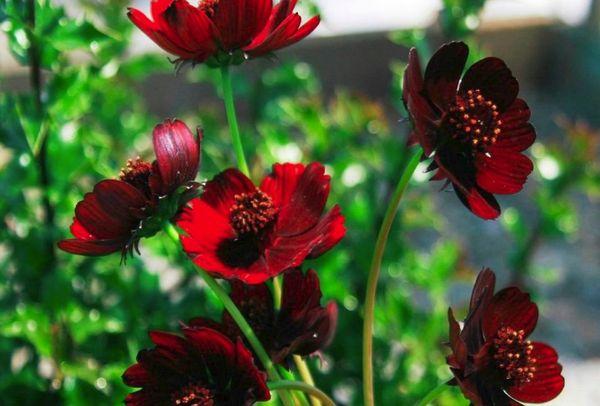
Brightness
The variety is semi-double. Flowers come in a variety of shades. These are mainly warm shades of orange and yellow. Due to their small height of 30 cm, they are used to decorate borders.
Antiquity
During the flowering period, the Activiti variety changes color from wine to delicate salmon color.
Double click rose bon-bon
Terry variety, tall bushes. Flowers are suitable for making bouquets. The inflorescences are lavender-pink. To make the inflorescences lush, it is recommended to plant bushes in sunny areas.
Terry
Terry varieties were bred not so long ago. The main difference from other varieties is the terry inflorescence. The shades of the petals are different.
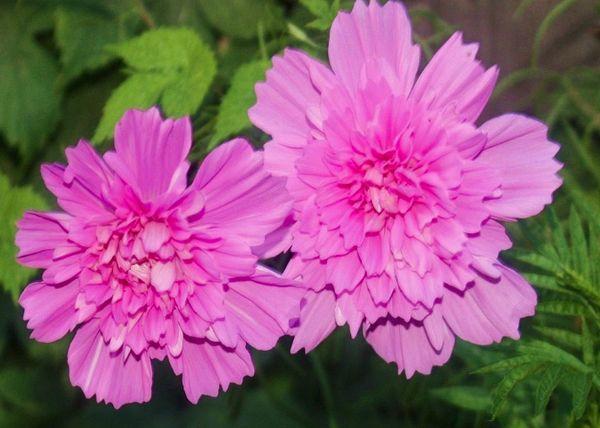
Golden Valley
The shade of the petals is orange-yellow. The bush is undersized, it grows up to 65 cm in height.
Polydor fox
The height of the bush is from 65 to 100 cm. The shade of the petals is yellow. The flowering period is long, starting in July and ending with the first frost.
Red Pyle
The shade of the inflorescence is raspberry pink. Bushes up to 75 cm high. Flowering continues until frost.
Burgundy button
Suitable for cutting, burgundy inflorescences. Plant height is 80 cm.
Chocolate
The peculiarity of this variety is the smell of inflorescences - it resembles sweet chocolate. The shade of the petals is blood red.
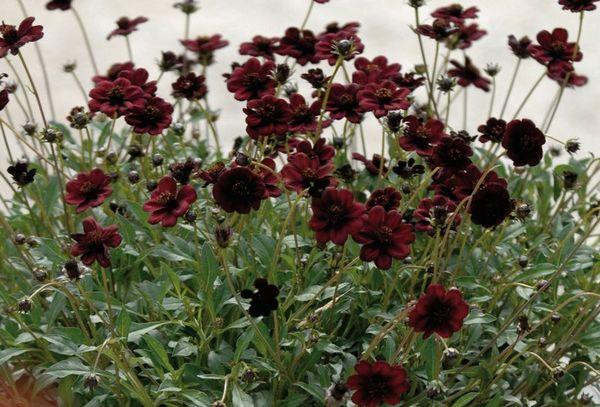
Dwarf
A low-growing variety, the height does not exceed 85 cm. Shades of petals are from black with a red tint to white.
Sensation
A mixture of inflorescence shades. The flowers of this variety are white, pink and salmon. There are varieties with white petals and a purple border around the edges. The height of adult bushes is up to 1.2 m.
Sonata
A low-growing variety, the height of the bushes is no more than 75 cm. The shade of the flowers is purple. The inflorescences are large, usually from 10 to 13 cm in diameter. The flowering period lasts from July to mid-October.
Seashell
The peculiarity of this variety is that the petals look like a tube, from this the variety was named Seashell. The shade of the petals is purple.
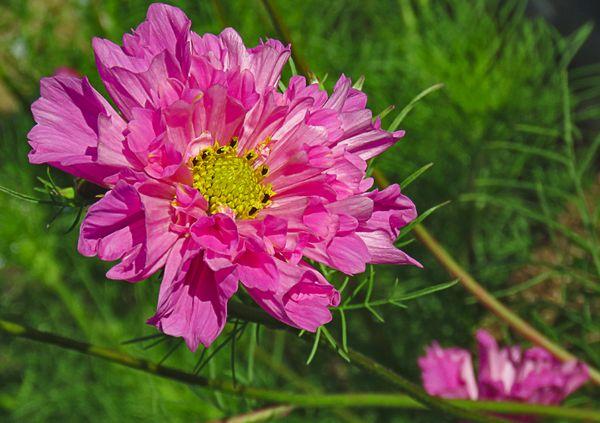
Pikoti
The petals of the flowers are white, with a purple border around the edges. The bushes grow up to 80 cm high.
Features of growing from seeds
You can plant kosmeya seedlings, or immediately sow planting material in open ground. Both methods are quite effective.
Sowing
The easiest way is to plant the plant immediately in open ground and wait for shoots. The culture grows quickly if the seeds are provided with favorable conditions.
Timing
Planting material is planted in warm soil in mid-May. If the spring is cold, it is better to postpone the planting until the end of May.
Landing scheme
Before planting the seeds, the soil is weeded and wood ash is added.
How to sow seeds:
- Make shallow holes.
- Plant the seeds 5-8 cm apart.
- Sprinkle lightly with soil.
At the end of sowing, irrigate the soil abundantly with warm water.
Seedling
Another way to grow cosmea is seedling. Seeds are first planted at home, and then transplanted into open ground.

When to plant
It is recommended to plant planting material in the first half of March so that the bushes have time to grow up by the time it is warm outside. When grown in southern regions, planting material can be planted in mid-February. And in the north - towards the end of March or the beginning of April.
How to plant
Make shallow grooves in the soil and plant seeds. Sprinkle lightly with soil and water abundantly. You can cover the boxes with cling film to help the seedlings rise faster.
Temperature
Kosmeya belongs to heat-loving crops, therefore, in order for the seeds to begin to sprout actively, they should be provided with all the necessary conditions. Seedlings appear at temperatures from +19 degrees. Lighting is also important. It is not recommended to place seedling boxes in the shade. Most of the day they should be exposed to the sun's rays. If the weather is often cloudy, you need to install artificial lighting and turn it on in the evenings.
Thinning
Thinning is necessary if the planting material was planted very densely and the bushes interfere with each other's growth. After the shoots appear and the seedlings grow a little, it can be thinned out. The weakest and smallest seedlings should be pulled out.
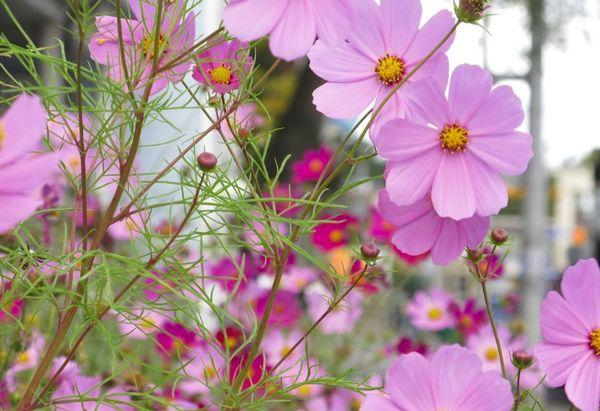
Dive
You need to dive seedlings into separate pots after a couple of full-fledged leaves appear on it. For picking, it is best to use peat cups, from which you do not need to extract seedlings later, but plant flowers with them.
Landing in open ground
Planting seedlings in open ground is done after the soil warms up well and warm weather is established outside. Usually, the transplant dates are at the end of May. It is recommended to plant bushes in a fertile, loose soil with a low nitrogen content.
How to plant a cosmeya in open ground:
- Dig holes and fill drainage on the bottom.
- Add a small amount of mineral fertilizers for flower crops.
- Plant seedlings.
- Bury the holes with soil and tamp lightly near the base of the stem.
Sprinkle generously with warm water at the end of planting. You can cover the seedlings at night. Although, if night frosts are not expected, you may not need to cover the plants.
Care
Probably, among all flower cultures, cosmea is the most unpretentious. It seems that it is enough to plant and water it sometimes. But if you make a little more effort, then the flowering will be long and abundant.
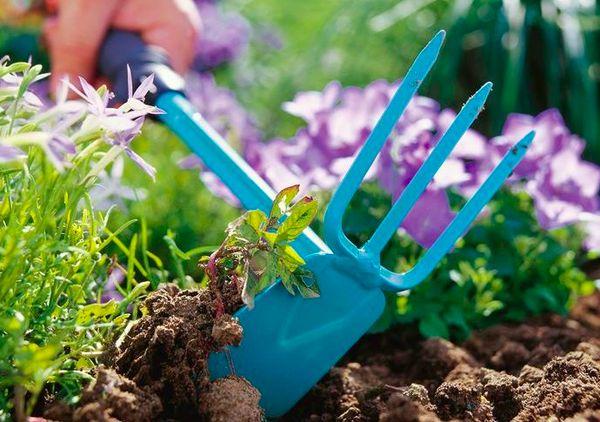
Watering
The plant is drought-resistant. You can water the bushes 2-3 times a week in the evening, after sunset. Water heated in the sun is used for irrigation.
Top dressing
Although kosmeya belongs to unpretentious crops and can do without fertilizing the soil, in order to increase the appearance of inflorescences, one should not forget about the regular application of fertilizing to the soil.
The first
Cosmey in the first half of the season, before flowering, is fed with nitrogen-containing dressings. The main thing is not to overdo it and not overfeed. Bushes cannot tolerate excess nitrogen in the soil and may even stop blooming. At least 14 days should pass between dressings. The plants are watered with nitrogen after irrigating the soil so as not to burn the root system of the bushes.
The second
The second feeding should be aimed at the formation of inflorescences and an increase in their number. Phosphorus and potassium are suitable for this purpose. Fertilize the soil in the evening. During fertilization, it is important not to let them fall on the foliage, but to water only the soil. Wood ash and weed-based infusions are suitable for organic fertilizing.
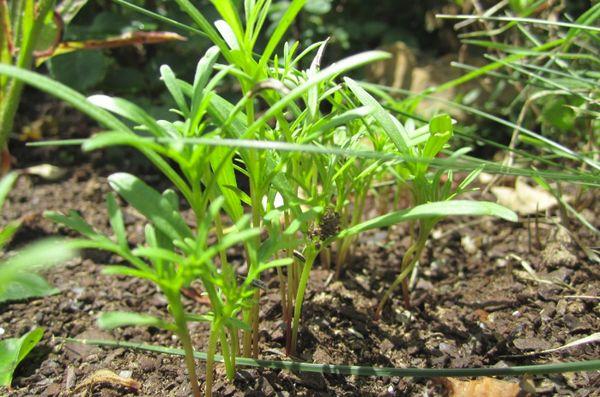
Third
The third dressing is applied towards the end of the growing season. If these are annual varieties, then you can do without it. And if they are perennial, then it is better not to forget about the third stage of fertilization. Top dressing at the end of summer is necessary in order to prepare the bushes for winter.
Rotted manure or bird droppings diluted in water are used as fertilizers. The introduction of organic fertilizers will prepare the bushes for winter. In addition, in the spring the soil will already be fertilized, and the bushes will begin to grow faster.
Breakage of wilted inflorescences
Regular removal of faded blossoms will extend the flowering period. The inflorescences are cut along with the peduncles at the base, where they are connected to the stem.
Pruning
Some varieties are annuals, they do not need to be cut in the fall, the bushes are completely dug up and thrown away.Perennial varieties are pruned in the fall, after a flowering period. The bushes are pruned so that the height of the stem from the ground is 15 cm.
Bloom
To increase flowering and increase its duration, you need to regularly apply top dressing to the soil and cut them off immediately after the inflorescences have faded.
Diseases and pests
The plant is resistant to disease and pest attacks. If you provide the bushes with favorable conditions for growth, then you will not have to fight diseases at the entire stage of growth.

Of the pests on the bushes, snails and slugs can appear. And then only when the seedlings are still small and weak. On adult bushes, as a rule, there are no harmful insects. Snails and slugs are collected by hand. You can also set up beer traps and burn them when insects crawl over them.
Collection and storage of seeds
The seeds are harvested from the culture after the inflorescences have completely faded and dried. It is recommended to store seeds in the refrigerator for no more than two years. It should be noted that kosmeya belongs to cross-pollinated crops, therefore, it will still not be possible to preserve varietal characteristics when collecting seeds.
Wintering
After pruning, the bushes are covered with spruce branches or agrofibre. Perennial kosmeya is cut so that only 15 cm of stems remain. You can also mulch the soil. When grown in southern regions, shelter for the winter is not required.
Use in landscape design
Kosmeya looks great in landscape design. It is used both for planting in summer cottages and in the urban landscape. The plant goes well with other flower crops.
Reviews
Alena, 35 years old: “As a child, in my grandmother's dacha, there was always a cosmea that I really liked. Until now, I cannot imagine a dacha without this flower. The plant is unpretentious and always blooms profusely. I especially liked the variety with double inflorescences. Flowers are like peonies. "
Karina, 26 years old: “This is not the first year I have been planting cosmeia. Seeds always sprout amicably and grow quickly. And the main advantage of this flower is that it blooms from the very beginning of summer until autumn. "

